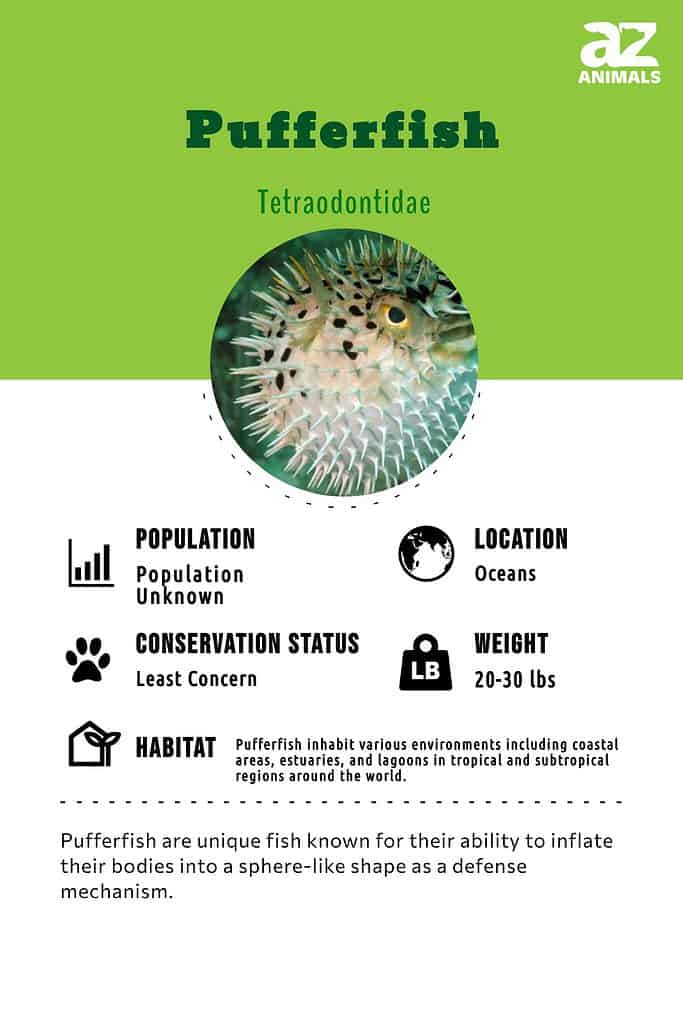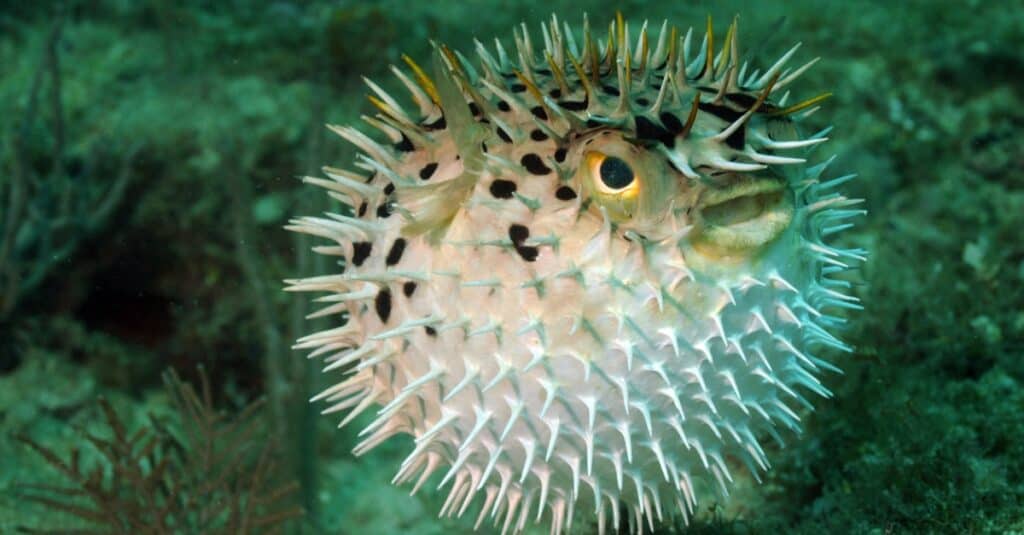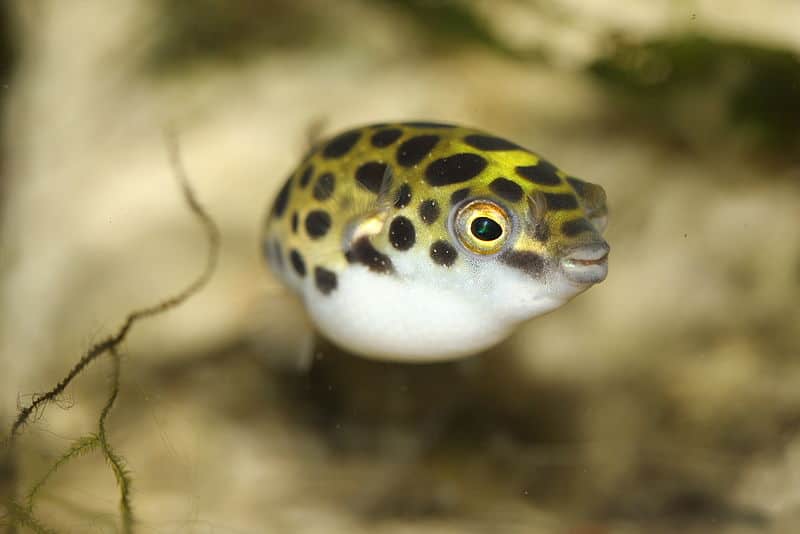Pufferfish
Tetraodontidae
Puffer fish love their mate
Advertisement
Pufferfish Scientific Classification
- Kingdom
- Animalia
- Phylum
- Chordata
- Class
- Actinopterygii
- Order
- Tetraodontiformes
- Family
- Tetraodontidae
- Scientific Name
- Tetraodontidae
Read our Complete Guide to Classification of Animals.
Pufferfish Conservation Status
Pufferfish Facts
- Main Prey
- algae, invertebrates, shellfish
- Group Behavior
- Solitary
- Fun Fact
- Puffer fish love their mate
- Estimated Population Size
- unknown
- Biggest Threat
- habitat loss
- Most Distinctive Feature
- inflatable air sack
- Distinctive Feature
- Inflatable body and sharp poisonous spikes
- Other Name(s)
- Blowfish, balloonfish, swellfish
- Gestation Period
- 4-7 days
- Optimum pH Level
- 5.7 - 6.4
- Habitat
- Tropics
- Predators
- Humans, Sharks, Large Fish
- Diet
- Carnivore
- Type
- Tetraodontidae
- Common Name
- Pufferfish
- Average Clutch Size
- 6
- Slogan
- The second most poisonous creature in the world!
View all of the Pufferfish images!

The pufferfish is a survivalist that thrives in nearly every tropical aquatic environment.
From freshwater puffers to saltwater Takifugu, these fish make use of a variety of adaptations to keep themselves safe from predators and humans alike.
In addition to the famous “puffing” technique, pufferfish can also attack with their beak-like teeth or poison an enemy with the toxins that they secret.
Although they are well-equipped to survive in the natural world, these fish still suffer in the exotic animal industry. Saltwater puffers are often hunted as a delicacy, and freshwater puffers are sold as pets.
A few species of pufferfish have become near threatened as a result of this activity; however, overall, the species is considered to be low-concern.
An Incredible Fish: 4 Pufferfish Facts

These are aggressive fish that are willing to attack anyone they perceive as a threat. Puffers usually live alone and do not usually share their territory with other fish.
©Rich Carey/Shutterstock.com
- Fighting instincts: These are aggressive fish that are willing to attack anyone they perceive as a threat. Puffers usually live alone and do not usually share their territory with other fish.
- Poison spikes: One of the adaptations that helps the pufferfish survive is the ability to produce a poison known as tetrodotoxin. This toxin is secreted across their body, making puffers dangerous to touch and even more dangerous to consume.
- Intimidating posture: These fish might look adorable when they’re puffed up, but the truth is that this trait is an intimidating survival mechanism. Few predators will stick around to eat a fish that has suddenly doubled in visual size.
- Romantic disposition: Despite their violent attitude towards humans and other predators, pufferfish are actually quite attached to their mates. The male usually helps the female lay her eggs by guiding her through the water and rubbing her side as she gives birth.
Click here for more interesting facts about pufferfish.
Evolution and Origins
The evolution and origins of pufferfish are not well understood. Pufferfish, also known as blowfish, is a group of fish that are known for their unique ability to inflate their bodies into a sphere-like shape as a defense mechanism. This group of fish is found in various regions around the world, including the coasts of Japan, Africa, and the Americas.
The earliest known pufferfish fossils date back to the Eocene epoch, approximately 56 to 33 million years ago. These ancient fossils suggest that pufferfish have existed in their current form for a long time, and have likely undergone little evolution over this time.
Pufferfish belong to the family Tetraodontidae, which is part of the order Tetraodontiformes. This order of fish is characterized by having four large, fused teeth that form a beak-like structure, and is thought to have evolved from ancient, bony fish that lived in the oceans millions of years ago.
Despite the lack of a clear evolutionary history, it is widely believed that the ability of pufferfish to inflate their bodies evolved as a defense mechanism against predators. By inflating their bodies, pufferfish can make themselves too large to be easily swallowed by predators, and can also produce a noxious substance that can deter predators from attacking.
Classification and Scientific Name

The scientific name of the pufferfish family is
Tetraodontidae.
©Tatiana Belova/Shutterstock.com
The scientific name of the pufferfish family is Tetraodontidae. This name translates to “four-toothed,” representing the four teeth that typically jut out from the fish’s mouth. These teeth are actually fused with the fish’s jaw, creating the resilience needed to break through hard shells.
Species

The stomach of a pufferfish can inflate up to three times its normal size.
©iStock.com/FtLaudGirl
There are at least 200 species of pufferfish in existence, which have been classified into 29 genera. Because these are such hardy and resilient fish, it’s easy for them to adapt freely to any environment.
Types of Pufferfish
Some of the most notable types of pufferfish include:
- Dwarf puffers: Dwarf puffers, or Carinotetraodon travancoricus, are tiny freshwater pufferfish that are native to the rivers of Southwest India. These fish are popular in aquariums, resulting in severe overfishing that threatens them in particular. Dwarf pufferfish may also be known as peak puffers or pygmy puffers.
- Nile puffers: Nile puffers or Tetraodon lineatus are one of the most popular kinds of freshwater pufferfish to keep as a pet. As the name implies, the gorgeous yellow-striped fish are found in the Nile river and throughout Africa.
- Takifugu: The genus of pufferfish native to the northwest Pacific Ocean is collectively known as Takifugu; these are the fish that were originally eaten as “fugu.” There are 25 different types of Takifugu, but they are all toxic.
Additional pufferfish include:
- Fahaka pufferfish
- Dichotomyctere nigroviridis
- Blackspotted puffer
- Colomesus asellus
- Black saddled toby
- Tetraodon
- White-spotted puffer
- Arothron
- Torquigener albomaculosus
- Sharpnose puffer
- Northern puffer
- Lagocephalus sceleratus
- Longnose puffer
- Canthigaster
- Lagocephalus
- Contusus
- Southern puffer
- Sphoeroides
- Blunthead puffer
- Pao
- Carinotetraodon irrubesco
- Torquigener
- Checkered puffer
- Bandtail puffer
- Guinean puffer
- Marilyna
- Eotetraodon
- Amblyrhynchotes
Appearance
These fish come in a wide variety of sizes, colors, and adaptations. Some puffers are tiny, and others weigh up to 30 pounds. Some of these fish have delicate spines, while others are covered in harsh spikes. However, they all share the same core feature: an air sack that can inflate when the fish feels threatened.
Another feature that almost all of these fish share is the presence of either a sharp beak, a set of teeth, or both. Pufferfish use their beaks and teeth to break apart shellfish; they also use them to aggress against other fish and various types of predators. Even babies are capable of seriously injuring anything that drifts by.
Aside from these features, they actually have rather distinct forms and faces. Takifugu looks completely different from Nile puffers, and pygmy puffers are far smaller than any of the other members of their species.
Distribution, Population, and Habitat
These fish can be found in all of the warm regions of the world. Whether they prefer saltwater or freshwater, most types like to live in secluded areas with plenty of covers. This typically means coral reefs, reed-covered marshes, and anywhere else where water and vegetation coincide.
Because they are not fished as a source of food, there have been no official counts of the population. Although the majority of pufferfish are labeled as least concern, nearly all types of Takifugu are considered to be near threatened. The most vulnerable types are those that are used as either exotic food or exotic pets.
Predators and Prey

These fish are predators and are known for being rather aggressive in fighting other fish off their territories. Pufferfish attack with their sharp hooked beaks, which are normally used for shelling mussels, crabs, and other shellfish.
Because they are covered in poisonous spikes, they have no real natural predators except sharks, which typically do not mind the presence of the poison.
Reproduction and Lifespan

The mating cycle is well-suited to this fish’s name. After two pufferfish have courted each other, the male pushed the female to a safe place along the shore. There, she lays her clutch of eggs, which are light enough to float on the surface of the water. The couple will likely remain in the area until the eggs are hatched.
Pufferfish eggs hatch within a week after they are laid. The baby pufferfish are usually too small to see, but they will grow quickly over the following months. A fully grown pufferfish can weigh as much as 30 pounds.
In the wild, most pufferfish live to be about 10 years old. Baby pufferfish do not stay with their parents and are usually eager to join the local ecosystem.
Fishing and Cooking

Pufferfish are toxic and are not considered food, they are still subject to fishing and poaching for the exotic industry.
Although pufferfish are toxic and are not considered food, they are still subject to fishing and poaching for the exotic industry.
In particular, misconceptions about Asian cuisine have led to the popularity of a delicacy known as “fugu,” which is simply a slice of hopefully non-toxic pufferfish meat.
Otherwise, pufferfish are frequently sought after as aquarium pets. It’s not uncommon for wild pufferfish to be pulled out of their environment and sold as pets around the world. Freshwater pufferfish are particularly susceptible to this because they can survive in a normal aquarium environment.
View all 192 animals that start with PPufferfish FAQs (Frequently Asked Questions)
Where are pufferfish found?
Pufferfish are found in the waters of nearly all tropical climates; some of them even swim as far as the temperate zones. In practice, this means you’ll find pufferfish near Southeast Asia, South America, and Africa.
Are pufferfish poisonous to touch?
Pufferfish are covered in spikes that drip with a deadly toxin. If predators make contact with the spikes, they will become sick and may even suffer a fatal injury. For this reason, it is not safe to touch a pufferfish with your bare hand.
What do pufferfish eat?
Pufferfish are carnivores that primarily eat shellfish. Pufferfish may also supplement their diet with smaller fish that cross their path.
What eats pufferfish?
Due to their toxicity, pufferfish have few natural predators. Tiger sharks often eat pufferfish, as do other species of shark.
Where do pufferfish live?
Pufferfish live in warm waters. They can be found in most tropical oceans and usually prefer to live near coral reefs.
What does pufferfish taste like
Pufferfish is not well suited for cooking, so it tastes tough and bitter. Eating pufferfish can be deadly and is not recommended.
What Kingdom do Pufferfish belong to?
Pufferfish belong to the Kingdom Animalia.
What class do Pufferfish belong to?
Pufferfish belong to the class Actinopterygii.
What phylum to Pufferfish belong to?
Pufferfish belong to the phylum Chordata.
What family do Pufferfish belong to?
Pufferfish belong to the family Tetraodontidae.
What order do Pufferfish belong to?
Pufferfish belong to the order Tetraodontiformes.
What type of covering do Pufferfish have?
Pufferfish are covered in Spikes.
What are some distinguishing features of Pufferfish?
Pufferfish have inflatable bodies and sharp, poisonous spikes.
How many eggs do Pufferfish lay?
Pufferfish typically lay 6 eggs.
What is an interesting fact about Pufferfish?
Pufferfish are the second most poisonous creature in the world!
What is the scientific name for the Pufferfish?
The scientific name for the Pufferfish is Tetraodontidae.
What is the lifespan of a Pufferfish?
Pufferfish can live for 10 years.
What is the biggest threat to the Pufferfish?
The biggest threat to the Pufferfish is habitat loss.
What is the optimal pH for a Pufferfish?
The optimal pH for a Pufferfish is between 5.7 and 6.4.
What is another name for the Pufferfish?
The Pufferfish is also called the blowfish, balloonfish, or swellfish.
How many Pufferfish are left in the world?
The population size of the Pufferfish is unknown.
How do Pufferfish have babies?
Pufferfish lay eggs.
What are the differences between pufferfish and porcupine fish?
The key differences between pufferfish and porcupine fish lie in their size, appearance, and family.
Thank you for reading! Have some feedback for us? Contact the AZ Animals editorial team.
Sources
- David Burnie, Dorling Kindersley (2011) Animal, The Definitive Visual Guide To The World's Wildlife
- Tom Jackson, Lorenz Books (2007) The World Encyclopedia Of Animals
- David Burnie, Kingfisher (2011) The Kingfisher Animal Encyclopedia
- Richard Mackay, University of California Press (2009) The Atlas Of Endangered Species
- David Burnie, Dorling Kindersley (2008) Illustrated Encyclopedia Of Animals
- Dorling Kindersley (2006) Dorling Kindersley Encyclopedia Of Animals
- Fishbase, Available here: http://www.fishbase.us/summary/FamilySummary.php?ID=448
- Science Direct, Available here: https://www.sciencedirect.com/science/article/pii/S2351989418300076
- Wikipedia, Available here: https://en.wikipedia.org/wiki/Tetraodontidae
- Aquafind, Available here: http://aquafind.com/articles/Puffer_Fish.php
- BYA, Available here: https://www.buildyouraquarium.com/freshwater-puffer-fish/

















